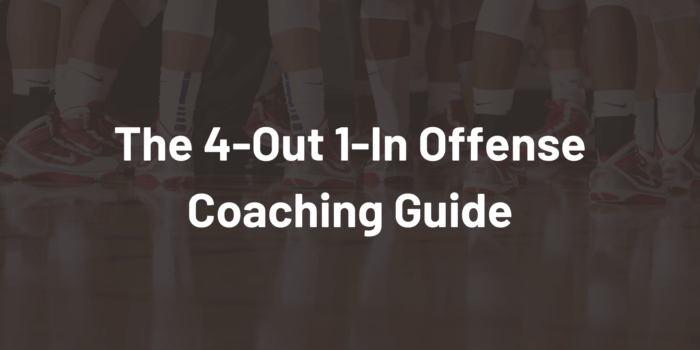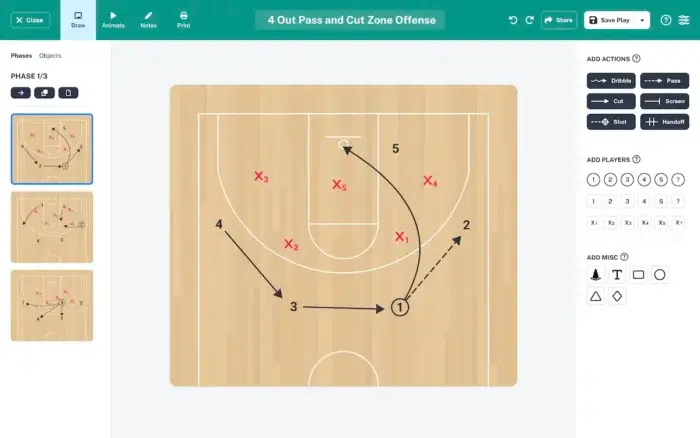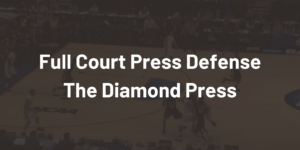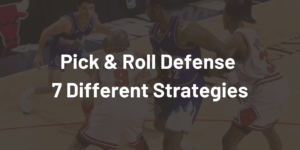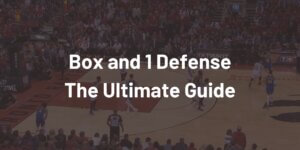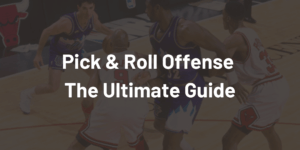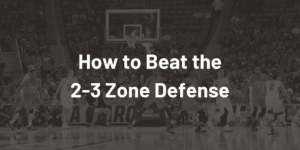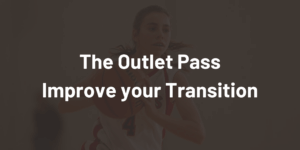The 4-Out offense is one of the most popular and versatile offenses in basketball and can be used at all levels of play - from youth basketball to the professional ranks.
Coaches use variations of this offense to run motion, set up their zone offense, and run some of the most popular offenses like Princeton and Dribble Drive.
In the 4-out 1-in offense, 4 players are positioned outside of the three-point line and one player is in the low or high post area.
The 4 players on the outside are typically positioned in the slots and wings, but you can also have players in the corners as well as flexibility with the inside player.
Here are a few things that make the 4-Out offense a great offense to implement for your team:
- It encourages great spacing around the perimeter and provides the offense with opportunities to dribble penetrate, use screens, and get backdoor cuts at the rim.
- It also provides post up opportunities (unlike 5-Out) for a player inside AND allows your team to run their offense through a playmaker at the high post or elbow area.
- You can run this offense on ANY level of coaching. You can teach the basics to youth / elementary players and teach the more advanced concepts to more seasoned players.
- The offense will feature lots of cutting, ball movement, player movement, and even screening.
- The 4-Out offense can be run as your core offense, but it can also be used to run set plays, quick hitters, and continuity-based actions.
- You can use it against man or zone defenses.
The Basics of the 4 Out Offense
Before we check out the concepts of the offense in more depth, here are a few concepts to consider. You’ll notice that a lot of these are like the 5-Out Offense - which is nice if you’d like to switch offenses based on personnel or matchups.
- On every catch, players should face the rim to look for open cutters, opportunities to pass it into the post, or chances to drive themselves.
- After every pass, players should cut hard to the rim like they are trying to score.
- Every cut must be to the rim - no backwards cuts! Once a player cuts to the rim, they must finish their cut instead of coming back to the ball.
- There is freedom within structure. Yes, we want to follow the “rules” of the offense, but it’s okay to make an offensive read based on what the defense gives you as well. Be difficult to guard!
- Follow these basic rules! One player doing their own thing or forgetting what they are supposed to do can interfere with the entire flow of the offense.
Alignment Options
There are several alignment options available to coaches when running the 4-Out Offense as well. Each has their own advantages and disadvantages.
1 and 4 are in the slots.
2 and 3 are on the wings.
In this alignment, the corners are filled by 2 and 3.
1 and 4 are in the slots.
In this alignment, 5 is positioned high to be used as a screener or facilitator. This also opens up driving and cutting opportunities with a player removed from the rim.
In this 4-Out alignment, 5 always stays on the opposite block (depending on the side the ball is on).
The Rules of the 4-Out Offense
1. Pass, Cut & Fill
- When you pass, you must basket cut. The first and most basic rule of the 4-Out Offense is that when you pass, you must basket cut - every single time! As players develop, a coach may want to add rules or give more options. In the beginning, this rule must be followed to the letter.
- Cut to score! An important teaching point here is that players should be “cutting to score”. Players must cut every time as if they might get the ball back for a layup (and sometimes they will). This puts more pressure on the defense and the rim. It will also open up the floor for better spacing.
- Fill the empty spots. Once a player cuts to the rim, the other players fill the empty spots. This movement becomes a habit pretty quickly because it makes sense. Just cut to the open spot next to you. The original cutter simply fills the open spot.
You could literally run this as your entire offense, especially on a youth level!
- 1 passes to 2
- 1 basket cuts all the way to the rim
- Players fill into the next spots
- 2 to the wing, 4 to the slot, 1 to the wing
The motion now continues based on what 3 does
2. If You Are Overplayed, Go Backdoor
- Go backdoor if denied. If a player is cutting towards the ball but finds themselves denied by the defense, they must go backdoor. A good rule of thumb is that if the defensive player is above the 3 point line, just go backdoor every time.
- Fill empty spots. This cut is now just like the cut a player would make after passing to a teammate. The cutter cuts all the way to the rim, the other players fill, and the cutter goes to the open spot.
- Make decisive cuts! Once a player decides to cut backdoor, they must finish their cut. No backward cuts or coming back to the ball are allowed. Once you cut, you cut!
- 1 passes to 2
- 2 cuts to the rim
- 1, 4, and 2 fill the open spots
- x2 denies the reversal pass to 2, so 2 goes backdoor for layup
3. If Your Teammate Dribbles At You, Go Backdoor
- If a player with the ball dribbles at you, you must go backdoor.
- The same rules for a normal basket cut apply here: cut all the way through and fill the next spot, other players rotate to open spot.
- Players must understand the difference between their teammates driving and attacking the rim and dribbling at them
- A north and south dribble to the rim is a drive.
- An east and west dribble to the side is a dribble at.
- As a rule of thumb, when a player dribbles directly at you and they are above the 3-point line, go backdoor.
- The spacing of the inside player is key. If they see a backdoor cut happening, they need to open up space for the pass by filling up and leaving the rim open.
4. If a Teammate Drives, the Other Players Rotate the Direction of the Drive
- On a drive inside the 3 point line and towards the rim (not a “dribble at”), the players will rotate in the direction the ball was driven.
- For instance, if the ball is dribbled right, players all move one spot to their right. If the ball is dribbled left, players all move one spot to their left.
- If you are in the corner and the ball is dribbled right, you are cutting to the rim. Some coaches elect to have the wing player fill to the corner instead of go to the rim on this type of drive since there is space to cut to (instead of in 5-out). It’s all about your personal preference as a coach.
- On a kickout, the passer basket cuts after their pass - just like they would do with any other pass.
- The other players now rotate and fill the empty spots
- 1 penetrates into the lane
- This triggers "circle movement" - players rotating in the direction of the drive
- In this diagram, we see what it looks like when 4 goes to the corner
- 1 penetrates into the lane
- This triggers "circle movement" - players rotating in the direction of the drive
- In this diagram, we see what it looks like when 4 cuts to the rim instead of fills the corner
Summary of the Basics
With those 4 basic “rules”, you can teach this offense to any level of basketball player or team. As a coach, you’ll want to make sure your players have mastered the previous rule before advancing to the next one.
Do not overload them with the entire offense at once! Teach it it in progressions, master each step, and then add on as you see fit. This will vary based on the experience level, age, and talent of your team.
If your team has these basic rules down (and you want to), you can progress to more advanced rules, concepts, and strategies.
Advanced Rules, Concepts, and Strategies
Off Ball Screens
- You can add a rule that states: once the ball is passed, the passer must set a screen away from the ball.
- The cutter who uses the screen now becomes the cutter to the rim and the same basic rules apply.
- When first installing this, it might be wise for the coach to instruct the player who is receiving the screen to always curl tight to the rim. Once this is mastered, the coach can give more freedom to the players to make their own reads and reactions (popping, flaring, rejecting the screen, slips, etc.)
- Also, for the screener, coaches should emphasize popping back out following the screen. Oftentimes the screener defender will help on the cut to the rim. This allows the screener to pop out and be open for a shot - and sometimes a drive to the rim against a recovering defender closing out.
- 1 passes to 2
- Instead of cutting to the rim, 1 screens away for 2
- 2 tight curls to the rim
- Everyone else fills the next open spot
- 1 comes back to the ball, 4 replaces 1, 2 replaces 4
Ball Screens / Pick & Rolls
- Another rule you could add involves ball screens. A coach could instruct their players to follow their pass and go set a ball screen. This could be an option within the offense or a specific automatic action for certain players on the roster (post players, for example).
- A roll to the rim would act just like any other basket cut in the aforementioned rules
- Being able to use the post player in the high post is very effective with ball screens - especially if they are random and not expected by the defense.
- 1 passes to 3
- Players all fill the open spots
- 5 sets a ball screen for 3 (5 rolls in this diagram but could also pop to the corner)
- 4, 2, and 1 all rotate in the direction of the ball
- 3 looks for 5 on the roll to the rim but also has kickout options in 1, 2, and 4
Post-Up Opportunities
- This is one of the benefits that the 4-Out Offnese has over the 5-Out. It’s much easier to get post touches for a post player inside.
- There are a few options when it comes to posting up AND placement of this player:
Post Player Positioning
One of the biggest advantages to running 4-Out is being able to utilize a player in the post. But where should you put this player? What should you have them do in the offense
1. Opposite Block
- If you’re using this option, the post player is always moving block to block depending on where the ball is located. This is a good option if you don’t have a super skilled post presence or a player who is more skilled at going and grabbing offensive rebounds than being thrown to in the post.
- The main roles of this player is to:
- Be on the opposite side of the ball so if his defender helps, penetrating guards can pass to him for a layup
- Clean up all offensive rebounds on the weakside
- This player can also be a screener, but will mostly be positioned near the block opposite the ball.
- If the ball is dribble or passed from one side to the other, this player will simply cut behind the rim with their butt to the baseline to the other side.
- This also makes cutting and screening on the ballside more effective since there is more space without a player standing on the block.
- 1 passes to 2
- As soon as the ball changes sides, 5 goes behind the rim and to the opposite ballside block
- 2 drives to the rim
- 1, 3, and 4 circle move in the direction of the drive
- 5 cuts to the opposite block
2. Ball Side Block
- If you’re using this option, you have a post player who is a threat when they catch the ball inside and you want to get them involved in your offense.
- This player will basically follow the ball based on what side it’s on.
- You can also use this player to set backscreens on the ballside.
- 1 passes to 2
- 1 basket cuts to the rim
- 1, 4, and 2 fill the open spots
- 3 can look to throw it into 5 posting up
- If 3 drives it baseline, 5 pops out to clear space to drive
- 1, 4, and 2 rotate to their next spots (in the direction of the ball)
3. High Post / Elbow
- With this option, you are positioning your inside player at the free throw line or elbows (think Princeton offense).
- This can really open up cutting to the rim since there is nobody on the block at all if you line up this way.
- This is also a prime position for the inside player to set screens for cutters going to the rim after they pass. They are in a great spot to set ball screens as well.
- You can also pass to this player and use them as a facilitator/passer from the high post spot.
- 1 passes to 2
- 5 screens 1 on his cut to the rim
- 3 and 1 fill the open slots
- Now, 5 sets a ball screen for 2
- 2 attacks off the dribble
- 3 and 1 move in the direction of the drive
- 2 reads the ball screen, 5 rolls, 4 replaces
- 2 makes the proper read
While this is not a set play, these are a few options your team can use by using 5 in the high post.
- 1 passes to 5 in the high post
- 5 could look to drive here since there isn't a lot of help
- 1 screens away for 3
- 3 curls tight to the rim
- 1, 2, 3, and 4 rotate to their next spots
- If nothing is there, 5 can run a dribble handoff with 1
- 1 gets the handoff and drives
- 5 rolls
- 2, 4, and 3 rotate to their next spots
- 1 makes the read
Quick Hitters
There a myriad of 4-Out Quick Hitters that you can use to easily flow from your 4-Out alignment. You’ll probably have more problems deciding which plays NOT to install rather than which ones to add.
Here are 3 simple and effective 4-Out Quick Hitters:
- 1 passes to 3
- 1 and 2 screen away for 4
- 4 can either curl and pop or curl tight to the rim
- 1 passes to 3
- 1 cuts first - if this is open, 3 can throw the lob
- 2 cuts second and looks for a pass for a layup
- 2 and 1 fill to corners
- 4 cuts high
- 5 sets a ballscreen for 3
- 5 rolls
- 3 makes the read
- 1 passes to 2 and sprints to corner
- 2 passes to 4
- Once 1 gets to corner, 5 sets a screen for 3
- 4 looks for 3 for a layup
- 5 and 2 then go screen away for 1
- 4 looks at 1 for an open shot
Transition Offense
- One of the most valuable things about using the 4-Out Offense is how easily it flows from your transition offense to your halfcourt offense.
- Most transition offenses have a big man sprinting to the rim (the rim runner), guards sprinting down the sidelines, the point guard handling the ball, and the trail man coming in behind the ball.
- As you can see, this VERY easily flows into 4-Out.
- You can either run your base offense or run some secondary offense options using the trail man.
- In transition:
- 1 has the ball
- 5 ran to the rim
- 3 and 2 got to the corners
- 4 trailed
- 1 uses the drag ball screen from 4
- 1 keeps the ball in transition and reverses to 4
- 2 cuts high
- 4 reverses to 2
- 5 sprints into a ballscreen with 2
- 2 attacks off the dribble
- 5 rolls
- 2 makes the read
Zone Offense
The 4-Out principles can also be applied to zone offense. Coaches have options here as well:
- Run the same actions and just cut through the lane and fill gaps.
or
- Instead of cutting all the way through, have players “button hook” cut into a gap for a second to occupy the high post. As soon as they see they are not getting the ball, they leave the high post and cut to the open spot they would have in the base man-to-man offense. Players continue to move the ball until they find an opening.
- You can also use the “inside” player in key spots here - you might instruct them to go short corner to short corner, to occupy the high post, or to set pin screens
- 1 passes to 3
- 1 cuts through to rim
- 5 flashes high
- 1, 2, and 4 all fill into the next spots
- 3 looks to pass to 5 in the high post
- On the catch, 5 looks to find an open player in a gap or to make a play for themselves
- 1 passes to 3
- Instead of cutting through, 1 "hooks" into a gap and "looks" for a pass from 3
- 5 is going short corner to short corner depending on where the ball is
- If 1 isn't open, they cut through
- Now, everyone fills their usual spots
- 3 passes to 2 and the motion continues with 3 hooking into the gap
- If 2 can pass to 3, 3 now looks for 5 from the high post for high-low action
Running a Roles-Based 4 Out Offense
- This is a more advanced version of the offense that would require your players to have a lot of experience both as basketball players and within a specific system…but would be very difficult to defend or prepare for.
- In this version of 4-Out, you give each of your players a rule.
- For example:
- Player A always sets ballscreens after reversing the ball. Player B always screens away. Player C and Player D always just pass and cut. Player E can choose to do whatever they think is best.
- Giving each player a specific rule/rules to follow allows the coach to utilize players and their strengths in unique ways.
Advantages of the 4-Out Offense
1. Your team will improve over the course of the season
- In this offense, each of your perimeter players play all fur perimeter spots during the season. They learn each spot and get a lot of repetitions in every part of the offense.
- Over the course of a season full of practices and games, they’ll become better basketball players simply by running the offense over and over again.
- Eventually, you’ll have 4 perimeter players on the floor at a time with a deep understanding and grasp of the nuances of the offense. They’ll also be highly interchangeable in their positions.
2. You can utilitize an inside presence
Regardless of the skill level of your one player that is inside, you can use them to your advantage in some capacity.
- A strong post player who can finish? Give them more touches inside.
- A weak post player who is better at offensive rebounding? Put them on the opposite block of the ball.
- A good screener and roller? Have them set ball screens high.
- A good creator and facilitator? Throw to them in the high post and let them make plays for your team.
Coaches can use this player in a multitude of ways.
3. Easy flow from transition
Most teams send one player to the rim in transition and have a trailer coming in behind the play. This flows directly into a 4-out base alignment and can give coaches flexibility in their transition attack.
4. More opportunities for offensive rebounding
Having a player inside gives the offense more chances for offensive rebounds and tip out situations.
5. More ground for the defense to cover/spacing for driving lanes
- As long as the inside player knows how and when to get out of the way, you’ll have more opportunities to drive in space with this offense.
- It sounds counterintuitive, but having only 4 players on the perimeter actually makes it a little tougher for the help defense to sit in the paint.
Disadvantages of the 4-Out Offense
1. The inside player may not get a lot of usage or involvement in the offense
Sometimes the inside player just doesn’t get the touches or involvement they would in another offense. This can make them “check out”, which causes them to miss opportunities to help their team.
Post players must therefore fully understand and accept their role in the offense for it to work optimally.
2. Reliance on outside shooting
- With the ball moving around the perimeter a lot and players looking to drive when given the opportunity, it can sometimes be easy to settle for a lot of perimeter shooting.
- Teams must make an effort to get shots inside or they will end up relying too much on the three point shot for success.
3. It’s easy for players to become robotic and just go through the motions
- Similar to other concept-based offenses, if players are simply passing the ball around the perimeter without looking for opportunities to attack, the offense can get quite stagnant.
- Players must be willing to read the defense and make a play when they have an advantage.
4. The inside player may become a distraction
- Sometimes teams will try too hard to get the inside player involved in the game. This turns into forcing passes inside, running actions for the post player that might not be optimal, and taking away opportunities for perimeter players to make plays.
- If you put too much focus on the inside player, the rest of the team will suffer and the offense will lose all flow and flexibility.
5. It can become too much of an “equal opportunity” situation.
- Just like the 5-Out Offense, if you aren’t running specific set plays and actions for your best players, everyone gets the chance to shoot and score.
- While this can be a good thing, teams would be wise to have their best players have the ball in their hands more, take more shots, and be most involved.
What Types of Teams Should Use the 4 Out Offense?
This offense is good for teams on any level, but there are also certain types of teams that it would be most beneficial for.
Some teams that would benefit from the 4-Out offense are:
- Youth Basketball Teams - this is a great offense to help assist in teaching the basic fundamentals of basketball - spacing, cutting, screening, reacting to the defense, and more
- Teams with an inside post presence -
- Teams with good shooting guards and playmakers - there will be plenty of drive-and-kick options, opportunities for perimeter shooting, and ballscreens with this offense
- Teams that need to hide a player - if you have an underdeveloped or weaker player on your roster, you can always put them in the inside post spot and use them as a screener and rebounder instead of using them as a player with the ball in their hands frequently
- Teams that master the offense! The more you practice this offense, the better your players will be. Stick with it, even if it is messy in the beginning - the repetitions over time will pay off!

Founder of thehoopsgeek.com. A passionate basketball enthusiast and coding geek, Andy combines a love for sports with technology.

